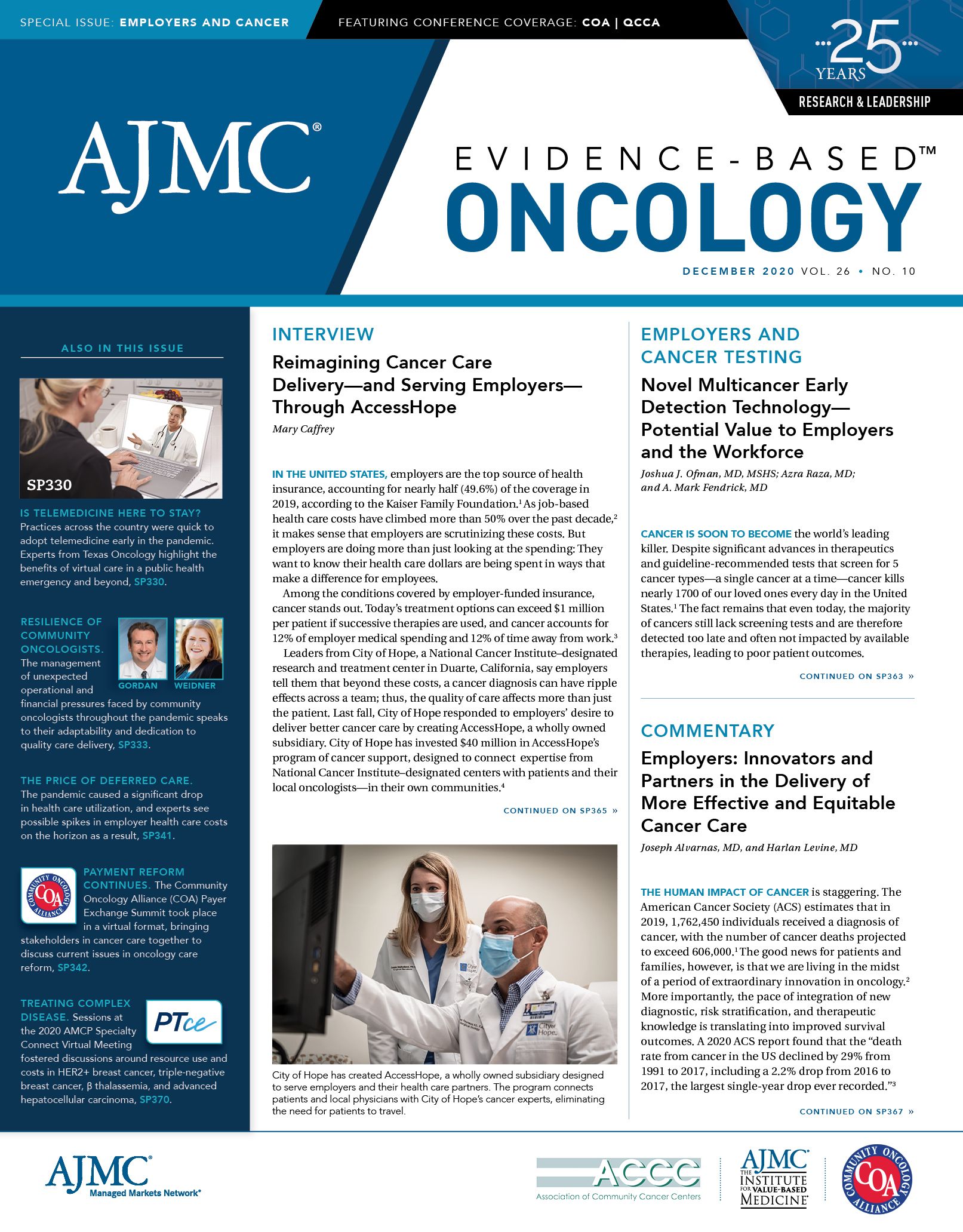Publication
Article
Evidence-Based Oncology
Defining Quality, Value in Cancer Care: What Employers Should Seek From Providers
Author(s):
A panel of key opinion leaders discuss how employers and self-funded companies should assess provider quality and value in cancer care at the 2020 Community Oncology Alliance Virtual Payer Exchange Summit.
At this year’s Community Oncology Alliance (COA) Virtual Payer Exchange Summit, the conversation on driving change within cancer care and cost reduction involves not only community-based oncology practices, but the employers and employer health groups who work with them as well.
With nearly half of the American population receiving health insurance through their employers, this year’s agenda placed a distinct focus on the role of these organizations, particularly how they can improve the quality, experience, and cost of cancer care.
However, as cancer care, or even general health care, is not typically the expertise of employers nationwide, how can these groups initiate change in a system they may not fully understand?
During a panel titled “Assessing Provider Quality & Value in Cancer Care: What Should Employers & Self-Funded Companies Be Looking For,” on day 1 of the 2020 COA Virtual Payer Exchange Summit, moderator Robert Baird Jr, RN, MSA, president of the National Cancer Treatment Alliance, opened the discussion by first asking Lalan Wilfong, MD, executive vice president of Value-Based Care & Quality Programs at Texas Oncology and COA Payment Reform co-chair, what signifies value and quality in oncology.
Wilfong, who was joined on the panel by John Fox, MD, chief boundary spanner at Foxworthy Healthcare Consulting LLC, and Lee Schwartzberg, MD, FACP, executive director at the West Cancer Center & Research Institute, discussed that while many major cancer centers advertise the quality of the care they provide, none have defined exactly what quality is.
“Is it access in getting patients in on a timely fashion? Is it following national standard guidelines? Is it patient outcomes, such as hospitalizations and emergency department visits....I think there's a lot of different aspects that go into what defines a good quality oncology experience for a patient, but it's hard to define that in a granular fashion to show that you are a good quality practice,” said Wilfong.
Building on the definition of quality in cancer care, Schwartzberg credited the introduction of the Oncology Care Model (OCM) in helping his organization delineate patient needs and pressure points to address from a quality perspective. Focusing primarily on reducing costs and improving the care process, he says that for those oncology practices who have addressed these concerns, a transition to outcomes that matter to employers, such as return to work or return to work for caregivers, is warranted.
While outcomes like overall survival may serve as the basis of quality assessment in clinical trials, from an employer perspective, it may not be as important as employees may not stay with their respective employers for an extended period of time, explained Schwartzberg. “I think we need to really dialogue with our employers and see what they feel are really tangible, important, quality metrics beyond what we've done already.”
Fox, whose occupation involves consulting directly with employers large, medium, and small, noted that information detailed in annual reviews include high-cost patients, their conditions, and their high-cost drugs. Moreover, Fox highlighted that the primary question asked by employers is based not on quality, but on what payers are doing to help control these costs.
This issue served as the primary takeaway from the panel discussion, in which improvement in transparency and effort is needed between payers, employers, and community cancer centers to delineate what quality is and how to maintain quality while additionally prioritizing cost-saving.
“We need to distinguish what is truly appropriate guideline-based therapy that helps patients do better, live longer, have better quality lives, versus those things that are potentially wasteful. And it's challenging sometimes to make that distinction, especially for employers who don't have knowledge of oncology and cancer therapy,” said Wilfong.
Addressing the total cost of care, panelists provided key strategies that employers should consider, including greater use of screening among employees and their family members, assessing cost related to site of service, and the use of biosimilars to drive down cost. Additionally, pathway management was referenced, which Wilfong notes for employers to approach with caution due to its growing use among oncology practices as an all-encompassing service.
“I have seen pathways where it's clear that the pathways weren't driven by efficacy measures, they were driven more by relationships, rebates,” explained Wilfong. “I would just take a step back, when you look at pathways, really make sure that there's not an underlying negative influence on developing those other than providing the best, most cost-effective care to patients.”
Developing a set criteria to identify practices associated with high value and cost-effectiveness was recommended by panelists, which Fox said can become a responsibility for payers to help bridge the gap in communication between employers and community oncology practices.
“The reality is that most practices don't have relationships with employers,” said Fox. “In defining a high value practice, I think payers can help filter for employers and identify those high performing practices so that employers, employees could search out those practices.”
In tackling the major disconnect between community oncology and employers, panelists concluded on how to improve the connection between community oncology and employers, which Schwartzberg said can prove difficult, especially among large employers due to the national scale of care required and the complicated nature of cancer.
“Having that dialogue is tough, I think probably the best way to do it is to do consortium discussions, like local business groups on health….with people that are well informed coming together and trying to solve this as a group rather than as an individual,” said Schwartzberg.





